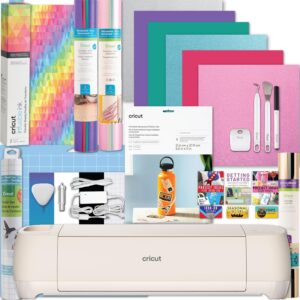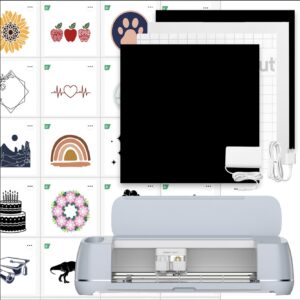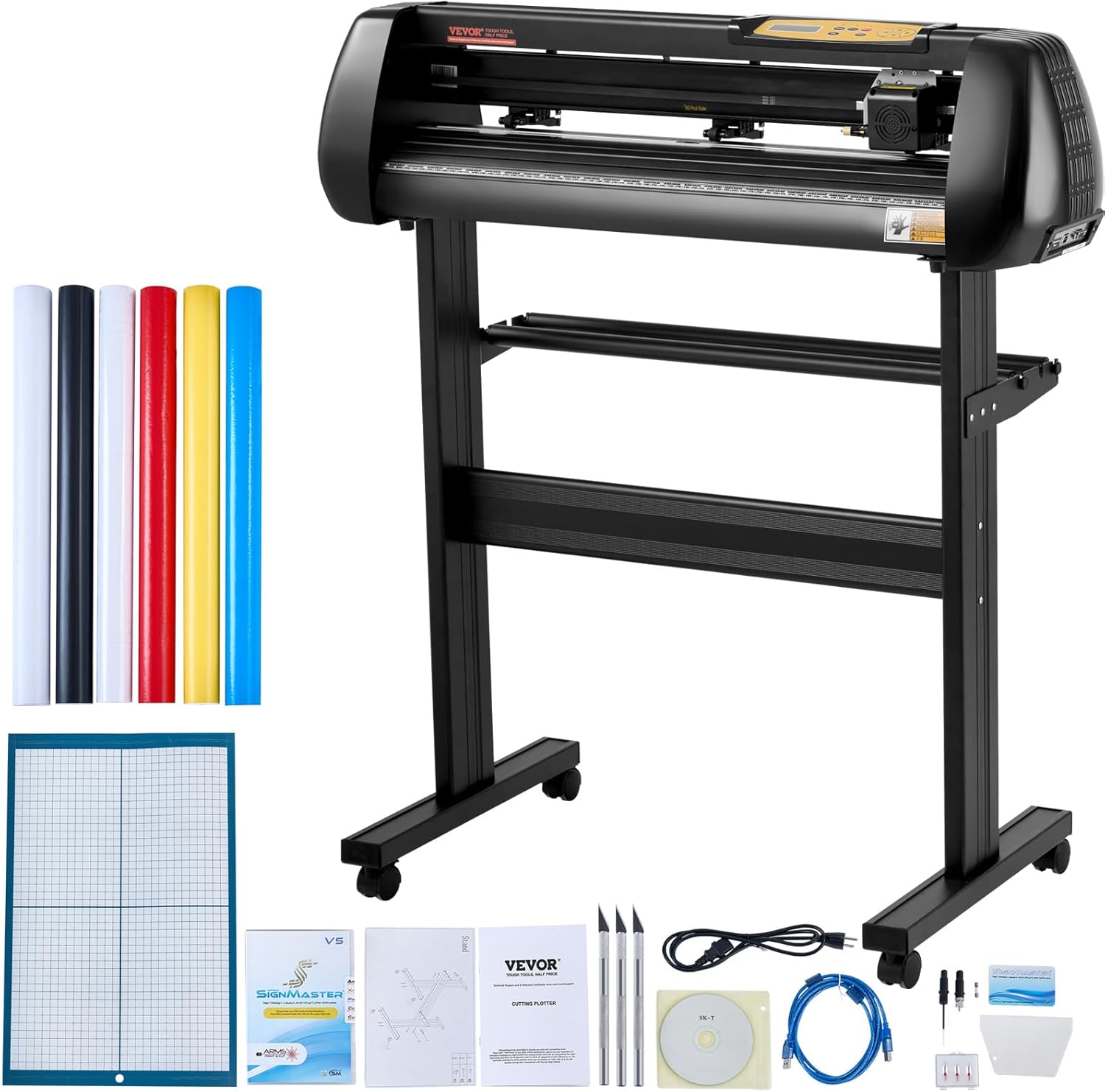I bought my first vinyl cutter after spending $200 on custom decals for my small business.
Two hundred dollars. For 50 stickers.
I did the math and realized I could buy the machine, learn to use it, and still come out ahead after the third batch. So I took the plunge.
That was three years ago. I’ve made thousands of decals since then—for my business, gifts, home projects, and yes, way too many laptop stickers. The machine paid for itself in two months.
Here’s what most people don’t realize: vinyl cutting isn’t hard. The machines do the heavy lifting. You just need the right cutter for what you’re making.
Whether you’re starting a side hustle, crafting for fun, or just tired of paying $8 for a single car decal, I’ll show you which cutters actually deliver and which ones end up collecting dust in your closet.
Quick Pick: Our #1 Recommendation
This is the machine I recommend to everyone starting out. It’s the newest version of Cricut’s beginner-friendly line, and they’ve fixed all the little annoyances from previous models.
The Design Space software walks you through every step. It cuts faster than older models and works with matless Smart Materials up to 12 feet long. And the built-in Bluetooth means no wrestling with USB cables.
It handles vinyl, iron-on, cardstock, and even thin leather. At around $250-300, it’s the perfect entry point that won’t feel limiting six months from now.
5 Best Vinyl Cutters (Tested & Reviewed)

Best For: Beginners who want professional results without a steep learning curve
This machine holds your hand through the entire process. Upload a design, select your material from a dropdown menu, and hit go. That’s it.
The Explore 4 is noticeably faster than previous versions—Cricut says it’s twice as fast. I’ve timed it. They’re not exaggerating.
Specs:
- 12-inch cutting width
- Cuts 100+ materials including vinyl, iron-on, and cardstock
- Works matless with Smart Materials up to 12 feet long
Pros:
- Design Space software is intuitive with thousands of free projects
- 2x faster cutting speed saves time on bigger projects
- Matless cutting with Smart Materials means less waste

Best For: Crafters who want more design freedom and offline capability
The Cameo 4 is what I upgraded to when I wanted more power and flexibility. It cuts thicker materials and doesn’t require an internet connection to work.
The software (Silhouette Studio) has a steeper learning curve. But once you get it, you have way more control over your designs.
Specs:
- 12-inch cutting width (15-inch model available)
- Cuts up to 3mm thick materials
- Built-in roll feeder for long projects
Pros:
- Can use any design software—not locked into one ecosystem
- More powerful motor handles detailed cuts better
- Roll feeder is perfect for making banners and long decals

Best For: Serious crafters ready to cut thick materials and fabric
This is Cricut’s powerhouse machine. I borrowed my friend’s for a weekend project and immediately understood why people love it.
The adaptive tool system means it can swap between a blade, scoring wheel, rotary cutter, and more. It cuts balsa wood, chipboard, and thick leather—stuff the Explore 4 can’t touch.
Specs:
- 12-inch cutting width
- 10x faster cutting than previous models
- Smart cutting feature with compatible materials
Pros:
- Cuts over 300 materials including fabric and basswood
- Matless cutting with Smart Materials (up to 12 feet long)
- Rotary blade cuts fabric without a stabilizer

Best For: Small business owners making large decals and signs
When I started getting orders for car decals and storefront signs, my 12-inch cutter wasn’t cutting it anymore. I needed something bigger.
The VEVOR handles 28-inch wide vinyl. That means full car hoods, large wall decals, and business signs without piecing anything together.
Specs:
- 28-inch cutting width
- Adjustable speed and pressure
- Compatible with SignMaster software
Pros:
- Massive cutting area for professional-sized projects
- Costs less than premium 12-inch machines
- Built-in LCD screen for standalone operation
What to Consider When Buying a Vinyl Cutter
Cutting Width Determines Your Projects
Most home cutters are 12 inches wide. That’s perfect for t-shirts, mugs, small signs, and typical crafts.
But if you’re making car decals, large banners, or storefront signs, you need 24 inches or wider. Just know that bigger machines take up serious counter space.
I keep my 12-inch cutter on my desk. My 28-inch machine lives in the garage because it’s the size of a small printer.
Software Can Make or Break Your Experience
Cricut’s Design Space is beginner-friendly but requires internet for most features. That drives some people crazy.
Silhouette Studio is more powerful but takes longer to learn. You can work offline, which I love.
Brother’s built-in software is great if you hate computers altogether.
Test the software before committing. Most brands offer free trials or have online simulators.
Material Compatibility Matters
All vinyl cutters handle adhesive vinyl and heat transfer vinyl. That’s standard.
But if you want to cut fabric, leather, balsa wood, or chipboard, you need a machine with more cutting force. The Cricut Maker 3 and Silhouette Cameo 4 handle these. Budget machines don’t.
Think about what you’ll actually make. If it’s 90% vinyl stickers, don’t overpay for features you won’t use.
Blade Quality and Adjustability
Cheap cutters often have fixed blade settings. You get what you get.
Better machines let you adjust blade depth and cutting pressure. This matters because different materials need different settings. Cardstock needs light pressure. Glitter vinyl needs more force.
I’ve seen people blame their vinyl when really their blade was just set wrong.
Built-In Storage and Tools
Some machines have built-in storage for blades, pens, and tools. Others are just the cutting mechanism.
This sounds minor until you’re digging through drawers looking for the scoring tool you need right now.
The Cameo 4 has built-in storage compartments. It’s one of my favorite features.
Software Subscriptions and Hidden Costs
Cricut requires a subscription ($10/month) to access their full design library. You can use the machine without it, but you’ll miss out on thousands of pre-made designs.
Silhouette charges for their premium software upgrade but doesn’t require a subscription.
Brother has no ongoing costs once you buy the machine.
Factor this into your budget. That “cheaper” machine might cost more over two years if you’re paying monthly fees.
Conclusion: The Right Cutter Pays for Itself Fast
Here’s the math that convinced me to buy a vinyl cutter:
Custom decals cost $4-8 each. A roll of vinyl makes about 50 decals and costs $15. Add in the machine cost, and I broke even after making 100 decals.
I passed 100 decals in the first month.
Since then, I’ve made custom gifts for every birthday and holiday. I’ve saved hundreds on business materials. And yeah, I’ve sold enough custom work to cover the machine cost three times over.
If you’re just starting out or crafting casually, get the Cricut Explore 4. It’s reliable, easy to learn, fast, and powerful enough to grow with you.
If you already know you love this hobby and want more power, jump straight to the Silhouette Cameo 4 or Cricut Maker 3.
If you’re starting a business and need to make big stuff, the VEVOR 28-inch cutter gives you professional capacity at a home-crafter price.
Stop paying other people to make things you could create yourself. The first time you pull a perfect decal off the backing paper, you’ll understand why people get addicted to these machines.
Frequently Asked Questions
What’s the difference between a vinyl cutter and a Cricut?
Cricut is a brand that makes vinyl cutters. It’s like asking the difference between a tissue and a Kleenex. Other brands like Silhouette and Brother also make vinyl cutters. Each has different features, software, and capabilities.
Can vinyl cutters cut wood?
Most standard vinyl cutters cannot cut wood. However, machines like the Cricut Maker 3 with a knife blade can cut thin balsa wood and basswood (up to 3/32 inch). For thicker wood, you need a CNC machine, not a vinyl cutter.
Do I need a subscription to use a Cricut?
No, but it’s limited. You can use Cricut machines without Cricut Access (their subscription). However, the subscription ($10/month) unlocks thousands of pre-made designs, fonts, and projects. You can still upload and cut your own designs without paying.
What materials can vinyl cutters cut?
All vinyl cutters handle adhesive vinyl and heat transfer vinyl. Mid-range machines cut cardstock, paper, and thin fabrics. Premium machines like the Cricut Maker 3 cut over 300 materials including leather, felt, chipboard, and thin wood. Check your specific machine’s capabilities.
Is a vinyl cutter worth it for a small business?
Absolutely. If you’re making decals, t-shirts, signs, or custom products, a vinyl cutter pays for itself quickly. I broke even in two months selling custom decals. The profit margin is excellent since materials are cheap compared to what customers pay.
Can I use any vinyl with my cutter?
Most machines work with any brand of vinyl, not just their proprietary materials. Cricut, Silhouette, and other brands all try to push their own vinyl, but generic vinyl from Amazon or specialty suppliers works fine. Just adjust your blade settings accordingly.
How long do vinyl cutter blades last?
With normal use, a blade lasts 3-6 months. Heavy use or cutting abrasive materials (like glitter vinyl) wears them faster. You’ll know it’s time to replace when you see jagged edges, incomplete cuts, or the blade skipping. Replacement blades cost $10-20.
What software do I need for vinyl cutting?
It depends on your machine. Cricut uses Design Space (free but web-based). Silhouette uses Silhouette Studio (free basic version, paid upgrades). Brother has built-in software. You can also use programs like Adobe Illustrator or Inkscape and import designs into your machine’s software.


